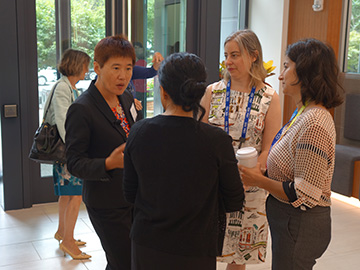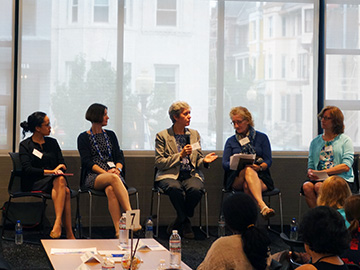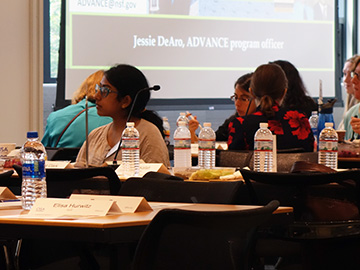
WiSTEE founder Jie Qiao discusses the morning's session with symposium attendees. [Image: Molly Moser]
Dozens of researchers, industry leaders and students rang in the first day of the Frontiers in Optics/Laser Science 2018 conference by attending the third international “Global Women of Light” symposium at OSA headquarters in Washington, D.C. A collaborative effort from WiSTEE Connect (Women in Science, Technology, Engineering and Entrepreneurship) and the OSA Foundation, the all-day program focused on career strategies to advance female leadership across career ranks and disciplines.
The symposium included both women and men from six continents, who collaborated through roundtable talks, panel discussions, workshops and networking sessions—illustrating WiSTEE’s focus on gaining regional connections to create global impact in science and technology.
Beating the odds
The program kicked off with an opening speech from WiSTEE Connect’s founder, Jie Qiao, and OSA CEO Liz Rogan. Qiao, an associate professor of optics at Rochester Institute of Technology, N.Y., USA, called for collaborative career advancement through building a holistic network of women. “Very few women beat the odds and rise all the way to the top of their careers,” she pointed out. She supported her claim with some “shocking, though not very surprising” statistics: only 2.5–5 percent of science and engineering department chairs are female; only 4 percent of fortune 500 companies have female CEOs; and some 46 percent of women in science occupations and 56 percent in technology occupations quit at mid-career.
Sobering as those statistics may be, Qiao also shared some encouraging facts. For example, she noted that gender-diverse companies are 15 percent more likely to have financial returns above the industry median. Such companies are also more likely to introduce radical new innovations in to the market. “We are valuable,” Qiao said. “However, women leave STEM jobs because they feel stuck in place.” Speaking to the lack of role models, mentorship and sponsors for women, she said “no one gets to the top alone.”
But if it takes approximately 20 years to change the culture of an organization, how do women survive and thrive in an imperfect system? According to Qiao, “It’s time to build our networks while participating in theirs.” On a similar note, OSA CEO Rogan spoke about OSA’s new honor acknowledging grassroots programs and people who are trying to effect change—the OSA Diversity and Inclusion Advocacy Recognition. “I really thought that this change would happen organically, but it didn't,” said Rogan. When it comes to creating behavioral change, “we’re trying to go the rewarding route.”
Strategies for success

Panelists Christie Canaria, Ulrike Fuchs, Ursula Gibson, Deborah Goodings, and Cathy Long. [Image: Molly Moser]
The roundtable discussion featured five leading women in different science and technology sectors: OSA President-Elect Ursula Gibson, Norwegian University of Science and Technology, Norway; Ulrike Fuchs, Asphericon GmbH, Germany; Deborah Goodings, National Science Foundation; Cathy Long, NASA Goddard Space Flight Center, USA; and Christie Canaria, National Cancer Institute, USA. The five shared their stories and gave advice for career advancement and leadership. Overwhelmingly, the speakers agreed that women need to network and to promote one another in their careers and achievements: “Build a network that suits you and you resonate with,” said Fuchs.
Although not everyone agreed with the somewhat calculating connotation of the word “strategies,” the panelists agreed that certain behaviors are helpful when looking forward to the next big opportunity. “Understand how the game is played: the structure, the rules, and how to get what you want out of the system is very important,” advised Canaria. She noted that “not everyone is going to be treated the same," so it’s essential to not assume that you’ll be automatically recognized for good work.
In line with the metaphor of “playing the game,” Gibson urged attendees, “Don’t assume that the rules can’t be changed.” Especially when it comes to balancing work and family life, it’s important to know that not everyone’s career timeline is going to be the same, but that you have the opportunity to “offer fresh solutions” as hurdles arise. Other career strategies that arose from the session included career coaching, making oneself visible, taking risks, being authentic rather than conforming to a more “masculine” leadership style, and finding a mentor.
Changing the system

An attendee listens to the keynote speech on "changing the system, not the people." [Image: Molly Moser]
After the panelists’ remarks, Jessie DeAro, program officer for the National Science Foundation’s ADVANCE program, took the stage to share her thoughts on “changing the system, not the people.” Even if proportional male/female representation is achieved at an institution, DeAro explained, equity issues can still exist. For example, an organization may have a 50 percent female workforce, but there could still be a demonstrable pay gap.
The ADVANCE program’s goal is not to funnel more women into STEM institutions, but rather to change workplace culture to make it equitable—so women can advance rather than fall prey to the proverbial leaky pipeline. “We don't want to keep putting more people into a system that is broken in some ways,” said DeAro.
That’s where the ADVANCE program and AAAS’s STEM Equality Achievement Project (SEA Change) come in. NSF has issued US$297 million in ADVANCE grants to over 160 institutions since the program’s inception in 2001. These grants go to organizations to fund organizational change, to support adaptation of research-based inclusive practices, and to support partnership projects that enhance gender equity in STEM academics.
Above all, the conversation at the symposium kept coming back to collaboration and tackling things together—across career levels, scientific disciplines and the academic, industrial and entrepreneurial sectors. “Little by little adds up,” said Goodings, “and we can make big changes.”
